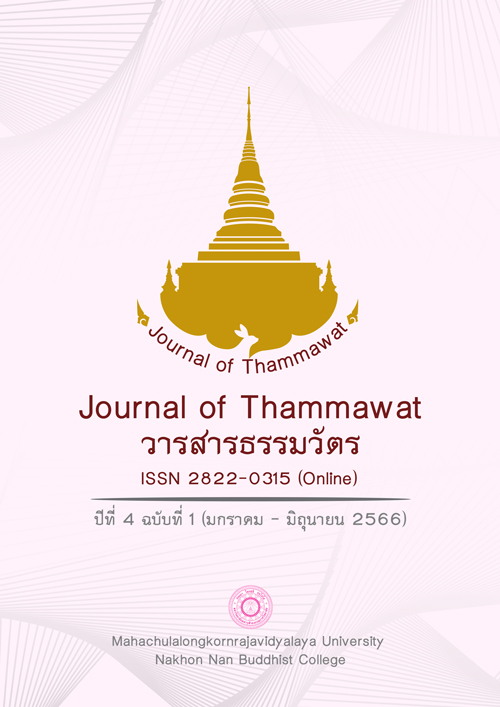A Study the Concepts and Morals That Appear in The Youth Literature Of Nai In Award "Ordinary Boy in The Land of Magic"
Main Article Content
Abstract
Research on this subject in the objective 1) to study the concepts in the Nai In Award Youth Literature, "Ordinary Boys in the Land of Magic" and 2) to study the moral principles that appeared in the Nai In Award Youth Literature, "Ordinary Boys in the Land of Magic". The researcher studied the research papers concerning the concepts and principles of morality and ethics in youth literature Nai In Award for "Ordinary Boys in the Land of Magic", Analyze, summarize, and discuss the findings of the descriptive research findings.
The results of the research showed that :
Regarding the concepts Nai In Award Youth Literature, "Ordinary Boys in the Land of Magic", a total of 15 chapters, appears in 4 concepts: 1) Conceptual concepts, 2)behavioral concepts, 3) visual concepts and events and 4) the expression of emotions.
In terms of morals, and ethics as appeared in the youth literature, Nai In Awards "Ordinary Boys in the Land of Magic" consists of 15 episodes, consisting of 12 aspects. The most common thing is compassion, followed by courage, courage, unity, patience, selflessness, discipline, individuality, gratitude, honesty. And the least solitude is perseverance.
"Ordinary boys in the land of magic" Is a youth literature with important content Is a presentation about the awareness of the importance of nature. We have to help maintain and maintain a lasting existence. In addition, it also includes insights into the main moral principles and practices living together, happily in society with other people Youth can bring ideas and the moral in the content to be adapted to be useful in daily life.
Article Details

This work is licensed under a Creative Commons Attribution-NonCommercial-NoDerivatives 4.0 International License.
References
ชลดา สุทธิวรกานต์. (2552). ศึกษาความขัดแย้งของตัวละครในเรื่องสั้น รางวัลนายอินทร์อะวอร์ด พ.ศ. 2550. (การศึกษาค้นคว้าด้วยตนเองศิลปศาสตรมหาบัณฑิต). มหาวิทยาลัยนเรศวร.
ชไมพร พรเพ็ญพิพัฒน์. (2549). คมความคิดในวรรณกรรมร่วมสมัย. กรุงเทพฯ: วัฒนาพานิช.
ชานนท์ ไชยทองดี และ คณะ. (2552). การวิเคราะห์วรรณกรรมอีสานเรื่องคดีโลกคดีธรรม. วารสาร
มหาวิทยาลัยราชภัฏมหาสารคาม, 3(2), 21-32. สืบค้นจาก https://so05.tci-thaijo.org/index.php/rmuj/article/view/30024
ธนัญชย์ ชัยวุฒิมากร และ บุปผา บุญทิพย์. (2559). แนวคิดคุณธรรมในนิทานสมัยใหม่: ด้วยรักบันดาล...นิทานสีขาว ของอาจอง ชุมสาย ณ อยุธยา. กรุงเทพฯ: มหาวิทยาลัยรามคำแหง.
พรรณทิตา ปานเอี่ยม. (2554). การวิเคราะห์วรรณกรรมเยาวชนรางวัลแว่นแก้ว ปี พ.ศ. 2552 ประเภทนวนิยาย. นครปฐม: มหาวิทยาลัยศิลปากร.
มานพ ถนอมศรี. (2546). การเขียนหนังสือ สารคดี บันเทิงคดี สำหรับเด็กและเยาวชน. กรุงเทพฯ: สิปประภา.
ราชบัณฑิตยสถาน. (2556). พจนานุกรม ฉบับราชบัณฑิตยสถาน พ.ศ. 2554. (พิมพ์ครั้งที่ 2). กรุงเทพฯ: ราชบัณฑิตยสถาน.
ศิวกานท์ ปทุมสูติ. (2553). คู่มือการอ่านคิดวิเคราะห์. กรุงเทพฯ: นวสาส์นการพิมพ์.
สมพร จารุนัฏ. (2541). คู่มือการเขียนเรื่องบันเทิงคดีและสารคดีสำหรับเด็ก. (พิมพ์ครั้งที่ 2). กรุงเทพฯ: องค์การค้าของคุรุสภา.
สาคร พูลสุข. (2553). เด็กชายธรรมดาในดินแดนแห่งเวทมนตร์. กรุงเทพฯ: อมรินทร์พริ้นติ้งแอนด์พับลิชชิ่ง.
สุภาสิณี คุ้มไพรี. (2557). การสืบทอดวรรณคดีและนิทานในวรรณกรรมเยาวชนไทยช่วงปี พ.ศ. 2545-2554. (วิทยานิพนธ์อักษรศาสตรมหาบัณฑิต). มหาวิทยาลัยศิลปากร.
สุวรรณา เกรียงไกรเพ็ชร. (2548). ทางสายใหม่แห่งวรรณกรรม ทัศนะวิจารณ์ต่อนวนิยายยุคแรก. กรุงเทพฯ: ชมนาด.
อมรา เล็กเริงสินธุ์. (2542). คุณธรรมจริยธรรมสำหรับผู้บริหาร. กรุงเทพฯ:เสมาธรรม.
อารยา ทองเพชร. (2550). การวิเคราะห์แนวคิดและกลวิธีการนำเสนอแนวคิดในวรรณกรรมสำหรับเยาวชนของ นงไฉน ปริญญาธวัช. (สารนิพนธ์การศึกษามหาบัณฑิต).
มหาวิทยาลัยศรีนครินทรวิโรฒ.


